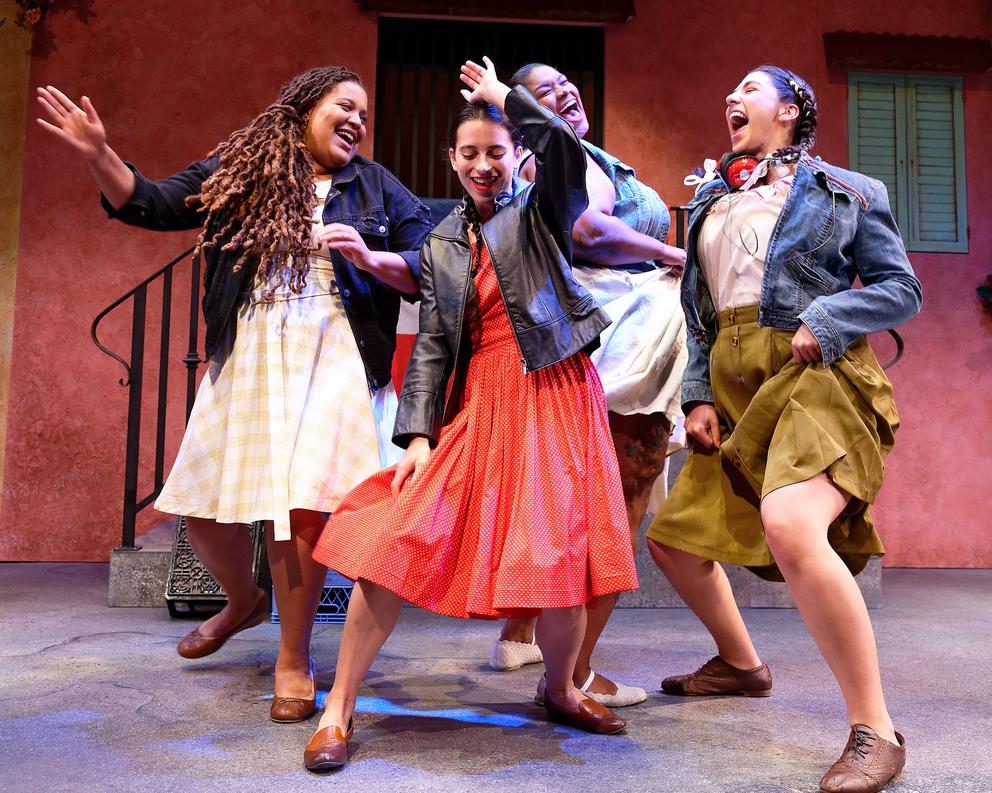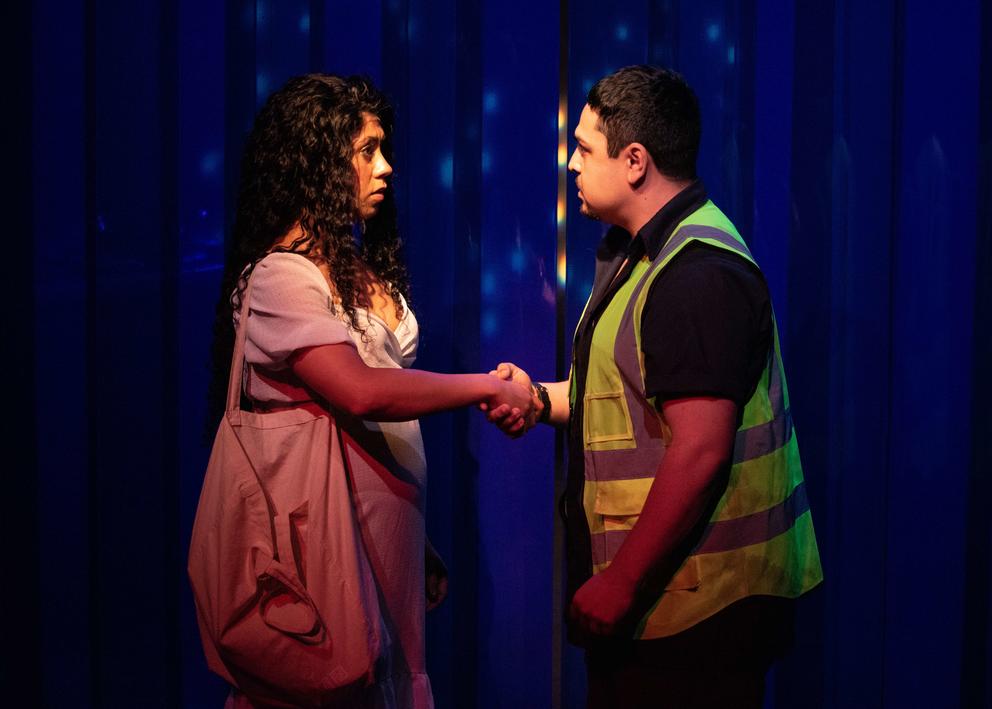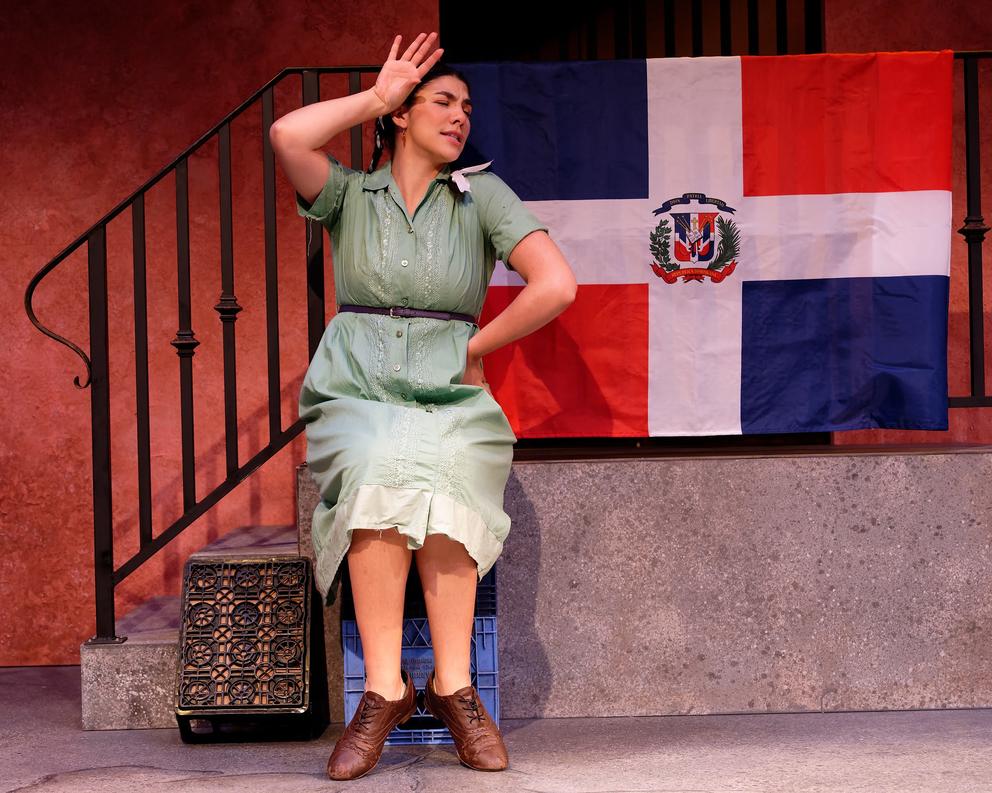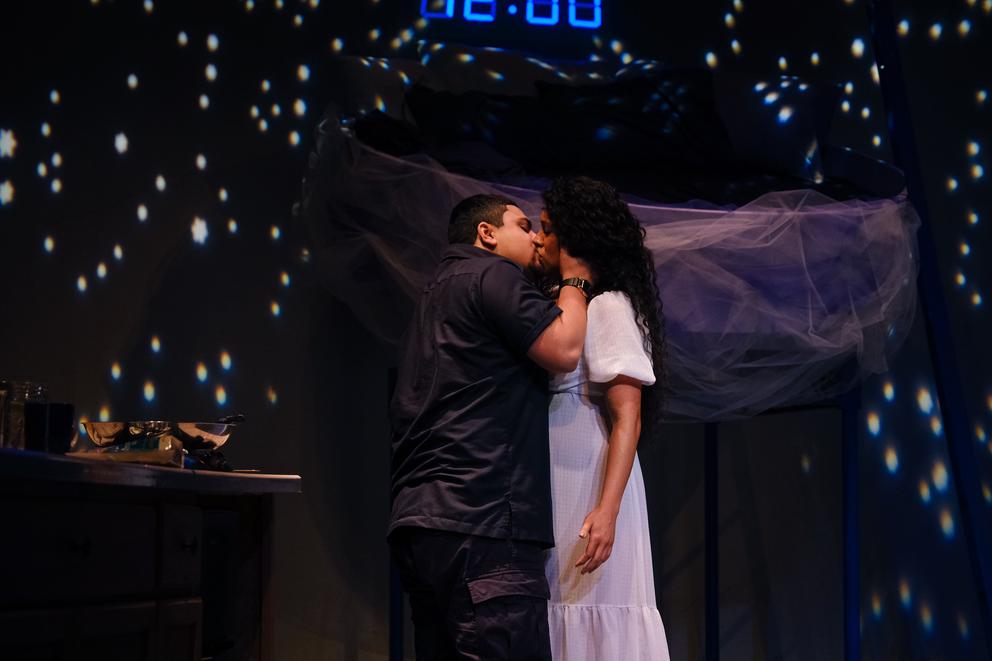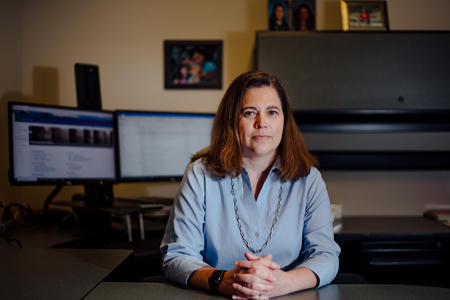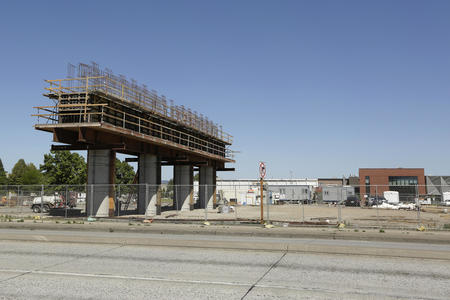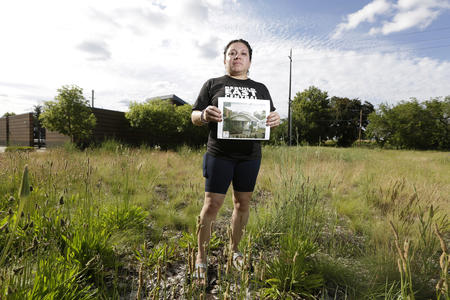“I can’t believe anyone’s out in that deluge,” he tells Celestina when they meet. “They’re calling it the storm of the century.”
Para leer este artículo en español, haga clic aquí.
As Seattle actor Myles Joseph Romo performs Aníbal’s lines during a recent matinee performance of Cloud Tectonics at Seattle’s 12th Avenue Arts, white letters appear on a TV screen to the left of the stage: “No puedo creer que haya alguien afuera en este diluvio. Lo están llamando la tormenta del siglo.”
The Spanish translation isn’t included in the stage notes for the 1995 magical-realist play by Puerto Rican playwright José Rivera. It’s an addition by Seattle’s Sound Theatre Company, part of a Spanish-captioning initiative in collaboration with Seattle’s Book-It Repertory Theatre, in hopes of making the play more accessible to Spanish-speaking audiences.
Sound Theatre is offering Spanish captions at four performances of Cloud Tectonics (co-produced with local theater organization Earthseed), including its closing-night performance (Oct. 15, 7.30 p.m.) at 12th Avenue Arts. At Seattle Center, Book-It is presenting the play In the Time of the Butterflies, playwright Caridad Svich’s adaptation of the novel by Dominican-American writer Julia Alvarez, in which she traces the Mirabal sisters’ famous resistance against the brutal Trujillo dictatorship in the Dominican Republic. Book-It is providing Spanish captioning during two performances of In the Time of the Butterflies (through Oct. 16, Spanish-captioned performance Oct. 15, 2 p.m., Center Theatre).
Captioning is common in opera, via English supertitles appearing above the stage, and English captioning for the deaf and hard-of-hearing community is gaining some traction in theaters (although progress is slow). But Spanish-captioning initiatives for play performances are rare in the U.S.
While Seattle has a deep history of bilingual theater, thanks to community theater groups like eSe Teatro and a strong contingent of local Latino and Latina playwrights and producers, Sound Theatre and Book-It’s joint project very likely marks the first time local theater organizations are offering Spanish captioning. The move puts the organizations at the forefront of a nationwide effort to make theater more accessible to non-native English speakers, immigrant communities and audiences of color.
“Making room for other languages, even if you don’t understand it, is a huge step for our city,” says Ana María Campoy, director of In the Time of the Butterflies. “It’s also a step for these arts organizations to acknowledge the communities that they have ignored, and to actually start making efforts to serve them and welcome them.”
“Sound Theatre is really pushing the envelope on accessibility,” says Elizabeth Ralston, a Seattle accessibility consultant and the founder of the Seattle Cultural Accessibility Consortium. The theater offered ASL-interpreted, Spanish- and English-captioned performances and sensory-friendly stagings of ‘Cloud Tectonics.’ Pictured here, left to right: Jay Woods and Myles Joseph Romo in ‘Cloud Tectonics.’ (Nikeesha Gooding/Sound Theatre)
Earlier this year, the American Blues Theater in Chicago asked Campoy — who is Chicana and has a local track record of staging and facilitating bilingual theater — to translate Benjamin Benne’s award-winning play Alma into Spanish. (Her translation will be used as captions during an Oct. 16 performance.) The experience left Campoy convinced Book-It should do the same for In the Time of the Butterflies.
Spanish, Campoy notes, is the oldest (and most widely spoken) non-Indigenous language on the continent. It’s also the most-spoken non-English language in the U.S. According to 2019 Census data, nearly 42 million people — or about 13% of the population — speak primarily Spanish at home, roughly 20% of whom don’t speak English well or not at all. (In Washington, more than 600,000 people, or 8.5% of the state’s population, speak Spanish at home.)
Campoy says the captioning initiative is meant to invite people who primarily speak Spanish — or just feel more comfortable in it — to the theater and make them feel welcome. But she also wants to extend a hand to Spanish speakers who don’t need the captions, and English speakers of Latin American heritage who maybe do not speak Spanish. In other words, the people who “want to go to the Spanish-captioning night because they know their community will be there,” as she puts it. (And it seems to be working: Some friends recently told Campoy the captions made it possible to bring their grandparents and other primarily Spanish-speaking family members to a showing of In the Time of the Butterflies.)
For Sound Theatre, offering Spanish captioning is also an extension of the theater’s focus on accessibility. Spanish-captioned plays are just one offering alongside ASL-interpreted and English-captioned performances for those who are deaf, hard of hearing, speak English as their second language and others.
“I think that the pandemic, and Zoom — starting to interact more digitally — has made us realize how non-inclusive theater has been for a long time,” says local theater artist Maria Manness, who manages the joint Spanish-captioning project. “And how many people — a wide range of accessibility identities — rely on captioning to enjoy media.”
“Coming back from the pandemic, what’s on our mind is: How are we really doing these stories justice? How are we inviting communities into our space?” says Jeannine Clarke, managing director of Book-It Repertory Theatre. Pictured here: Sofía Raquel Sánchez in ‘In the Time of the Butterflies.’ (Anthony Floyd/Book-It)
Manness learned the art of Spanish captioning as intern running supertitles for bilingual plays at Portland’s Milagro Theatre fifteen years ago. She recently introduced English captioning during performances of Tin Cat Shoes at Washington Ensemble Theatre (WET), where she is currently a managing director.
“The technology and the process is actually surprisingly simple,” Manness says. For Tin Cat Shoes’ captioned performances, audience members could scan a QR code, which opened a web page where the lines appeared on screen as actors uttered them. For the Spanish captioning at Center Theatre and 12th Avenue Arts, Manness opted for TV monitors next to or above the stage, but the basic system is still the same: A person sitting offstage with a laptop makes sure the captions appear at the right time, thanks to a prepared PowerPoint presentation. (Which of course could create issues if actors go off-script or start improvising.)
Still, in a quick poll of a dozen local theater organizations, some said they would like to offer English and/or Spanish captions, but that figuring out the technology (and sometimes the cost of acquiring or operating it) was a barrier. Manness says she hopes these theaters will tap into the know-how of Sound Theatre, WET and Book-It. “We already know how to do this — you can just hire us,” she says.
“I’m very happy to see this particular Spanish-captioning partnership… When more than one theater is doing it, the word starts to get out… and theaters start thinking: If Sound Theatre can do it, maybe we can?”, says Aimee Chou of Sound Theatre. Pictured here, left to right: Myles Joseph Romo and Jay Woods in ‘Cloud Tectonics.’ (Aaron Jin/Sound Theatre)
Book-It and Sound Theatre are looking ahead to their next plays and hope to continue offering Spanish captioning in some form in the future. Seattle Rep is planning to offer Spanish captioning during I Am Not Your Perfect Mexican Daughter early next year and says it will “continue to explore this” as an option for other productions as well.
Burien Actors Theatre said it was hoping to revive a Spanish-captioned show that was canceled due to the pandemic. The 5th Avenue Theatre and Village Theatre also told Crosscut they are interested in offering Spanish captions at future shows, and Manness of WET said she’s hoping to continue “experimenting” with Spanish and English captioning as well.
“That’s what’s most exciting to me, the possibility of this being a movement in Seattle,” Manness says. “The more that it is available, and the more that it grows, the more commonplace it becomes, the more audiences will come to expect it and will feel like they are welcome at all theaters in Seattle.”
But many involved in the project warn this is just a beginning. Rather than calling it a success (box-office numbers have yet to be crunched, audience feedback analyzed), they say these are first steps in the right direction. It takes time to build trust and relationships with communities long excluded from the theater — behind the scenes, on the stage and in the seats.
“We also have to make sure that the stories we’re telling with the Spanish captioning are actually meaningful to the audiences,” says Grecia Leal Pardo, a Seattle-based Mexican theater artist and Spanish translator (and sometimes caption operator) of Cloud Tectonics. Offering captions only for plays with a connection to Latin American culture is insufficient, she says; it should be an ongoing conversation. “It’s building up a relationship,” Leal Pardo says. “You can’t just do it sporadically, and every two years be like: ‘Oh, by the way, remember two years ago, when we offered it? We’re gonna do it again’… It has to be more constant.”
Get the latest in local arts and culture
This weekly newsletter brings arts news and cultural events straight to your inbox.

